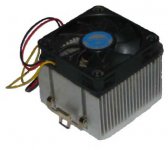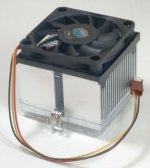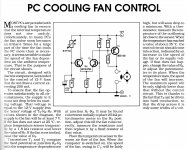hi every body i have yet another problem ........... heat sinks r becoming costly day by day and becoming hard to find ... i have a bunch of amd cpu heat sinks .... R they any good for amps ....... even if i put 1 heat sink per 2 device will it be ok ... how much heat can these heatsinks dissipate with forced cooling ???????
I am actually planning on making dx blames st can i use these cpu heatsink ???????
regards
aniket
I am actually planning on making dx blames st can i use these cpu heatsink ???????
regards
aniket
Attachments
Last edited:
yes , 1 amd HS for each OP device. These are designed for 50 - 100 watts apiece (processors).
Screw 4 on a piece of 1/8" angle and you can dissipate satisfactorily 2 - 50-60 watt class B amps (4 devices).
For a very hot environment and/or inadequate ventilation use a couple of 80mm PC fans at 7 volts (quiet) to supplement this arrangement.
OS
Screw 4 on a piece of 1/8" angle and you can dissipate satisfactorily 2 - 50-60 watt class B amps (4 devices).
For a very hot environment and/or inadequate ventilation use a couple of 80mm PC fans at 7 volts (quiet) to supplement this arrangement.
OS
hi every body i have yet another problem ........... heat sinks r becoming costly day by day and becoming hard to find ... i have a bunch of amd cpu heat sinks .... R they any good for amps ....... even if i put 1 heat sink per 2 device will it be ok ... how much heat can these heatsinks dissipate with forced cooling ???????
I am actually planning on making dx blames st can i use these cpu heatsink ???????
Did you check on ebay? they always have hefty heatsinks there and they are not too expensive. in my case, I do not like using fan for cooling the heatsink.
PC heatsinks are OK!
Hi,
Take a look at what I have done (photo is DX Blame ST!!!😎).
This is an original AMD heatsink.
But be careful with noise. A fan speed control would be nice in order to reduce unwanted noise, and also for longer life.
I believe that original Intel Pentium heatsinks are much better than AMD's, although they have a smaller area to fit devices.
Tell us later your approaches.
All the best,
Max.
Hi,
Take a look at what I have done (photo is DX Blame ST!!!😎).
This is an original AMD heatsink.
But be careful with noise. A fan speed control would be nice in order to reduce unwanted noise, and also for longer life.
I believe that original Intel Pentium heatsinks are much better than AMD's, although they have a smaller area to fit devices.
Tell us later your approaches.
All the best,
Max.
Attachments
-
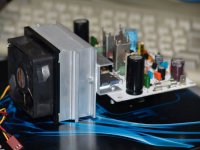 OgAAAKF1KkPEFpW329ZVZ8z1_g2_6St-wpRlf7gCEeqofz7fX9QbTthNAjb-fMTmzmXhIqFzEEbGVAyOm8L2Q3GvZ9wAm1T1.jpg56 KB · Views: 251
OgAAAKF1KkPEFpW329ZVZ8z1_g2_6St-wpRlf7gCEeqofz7fX9QbTthNAjb-fMTmzmXhIqFzEEbGVAyOm8L2Q3GvZ9wAm1T1.jpg56 KB · Views: 251 -
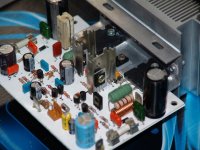 OgAAAB2V0xXuB3MVSt684VArMar8mrew7N6jf9oETA5pv-uzhbIgHMmK7m9zce9GXPmC2iEuvxKTPA_R2_Qv7-nSiS4Am1T1.jpg79.8 KB · Views: 250
OgAAAB2V0xXuB3MVSt684VArMar8mrew7N6jf9oETA5pv-uzhbIgHMmK7m9zce9GXPmC2iEuvxKTPA_R2_Qv7-nSiS4Am1T1.jpg79.8 KB · Views: 250 -
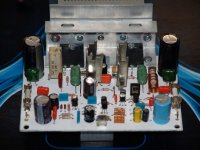 OgAAAJeUXuaLKbbyNZckzfw-xgLYXNB7IW2-PgDOGfx2winFtIvXfOJKMjxzy0GMIarRTEKZbgIJrn-a1B6FeW6coeQAm1T1.jpg68.8 KB · Views: 237
OgAAAJeUXuaLKbbyNZckzfw-xgLYXNB7IW2-PgDOGfx2winFtIvXfOJKMjxzy0GMIarRTEKZbgIJrn-a1B6FeW6coeQAm1T1.jpg68.8 KB · Views: 237
Last edited:
thanks smartx21 ............ i actually downloaded ur video from youtube ........... quite impressive can u give a few details .............
1. supply voltage
2. speaker impedance
3. were u running the amp at full power?
4. how hot was the heat sinks ....????
regards
aniket
1. supply voltage
2. speaker impedance
3. were u running the amp at full power?
4. how hot was the heat sinks ....????
regards
aniket
Enjoy!!!
The circuit is original DX Blame ST, fed with 35+35DCV, 8 ohm-speakers (maybe lower than this), I pushed it to the max without any noticeable distortion, but I cannot measure the actual output power (at least I haven't tried so!).
If fan is on, no trouble. No need for fastest speed. As said above, 7V is fine. If you prefer, install a controller, with heat sensor. I can provide two circuits, if you need. But never try to run it without the fan at maximum power!!!
"Enjoy good sonics!", as told by the author.
All the best,
Max.
Hi,can u give a few details .............
1. supply voltage
2. speaker impedance
3. were u running the amp at full power?
4. how hot was the heat sinks ....????
The circuit is original DX Blame ST, fed with 35+35DCV, 8 ohm-speakers (maybe lower than this), I pushed it to the max without any noticeable distortion, but I cannot measure the actual output power (at least I haven't tried so!).
If fan is on, no trouble. No need for fastest speed. As said above, 7V is fine. If you prefer, install a controller, with heat sensor. I can provide two circuits, if you need. But never try to run it without the fan at maximum power!!!
"Enjoy good sonics!", as told by the author.
All the best,
Max.
thanks smartx21 ........... plz provide the temperature controller circuit .......
regards
aniket
regards
aniket
Fan Control
Hi,
This is from Elektor (moderators: may I?).
In fact, I haven't tried this circuit, but it seems to work fine. All you have to do is tune your sensor (you may also try other kind of sensors, depending on your skills).
Other circuit I have is a bit more complex, with a dual op-amp and a RED LED as heat sensor (!!!).
All the best,
Max.
Hi,
This is from Elektor (moderators: may I?).
In fact, I haven't tried this circuit, but it seems to work fine. All you have to do is tune your sensor (you may also try other kind of sensors, depending on your skills).
Other circuit I have is a bit more complex, with a dual op-amp and a RED LED as heat sensor (!!!).
All the best,
Max.
Attachments
Of course, you will need 12V from a 35+35V supply, or a separate winding to feed this circuit. If you plan to use speaker protection (delay, short circuit, DC), than you sure will need a separate supply for these sections of the whole project!
Regards,
Max.
Regards,
Max.
Ive played around with these fan controller things. They are really a lot of fun and frustrating at the same time, mainly because they tend to turn on and off rapidly because most times it has little to no hysteresis. I recognize that image from Elecktor as one of those "text book" designs that looks good in theory. As soon as the fan speeds up it quickly cools the thermistor, slowing it down immediately, again and again. Better results are to glue the sensor to a large mass like the heat-sink, instead of just hanging it in the airflow. better yet is to use 2 different set points for on to off.In fact, I haven't tried this circuit, but it seems to work fine.
Last edited:
Soundcraft (among many others I'm sure) uses an opamp as a servo to maintain a constant heatsink temp in several of their console PSU's.
- Status
- Not open for further replies.
- Home
- Amplifiers
- Solid State
- are these heatsinks suitable?????????????
